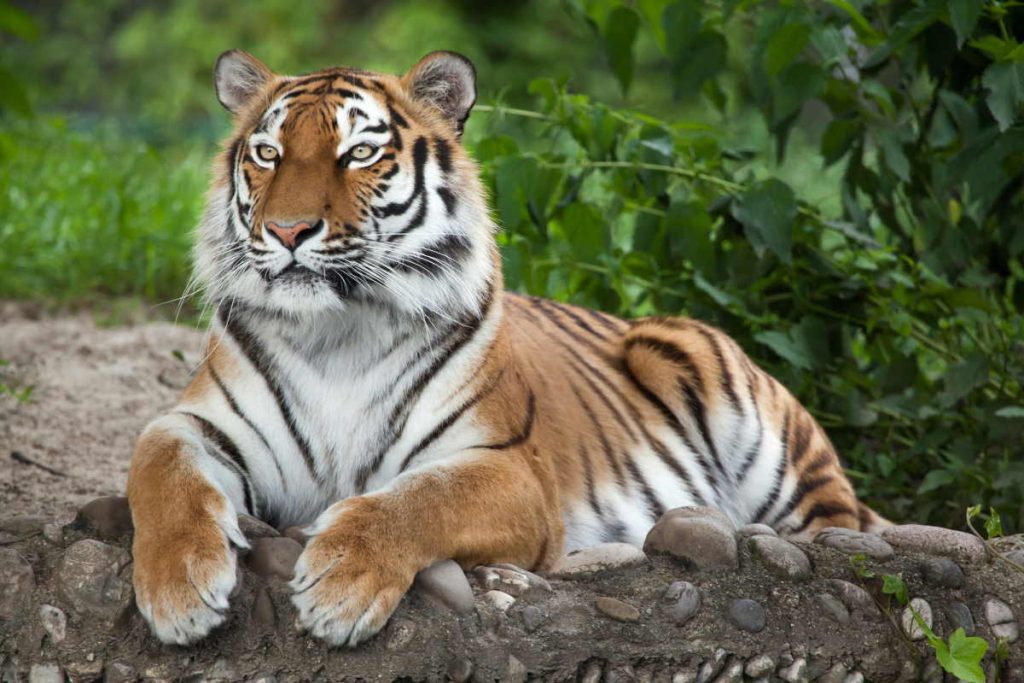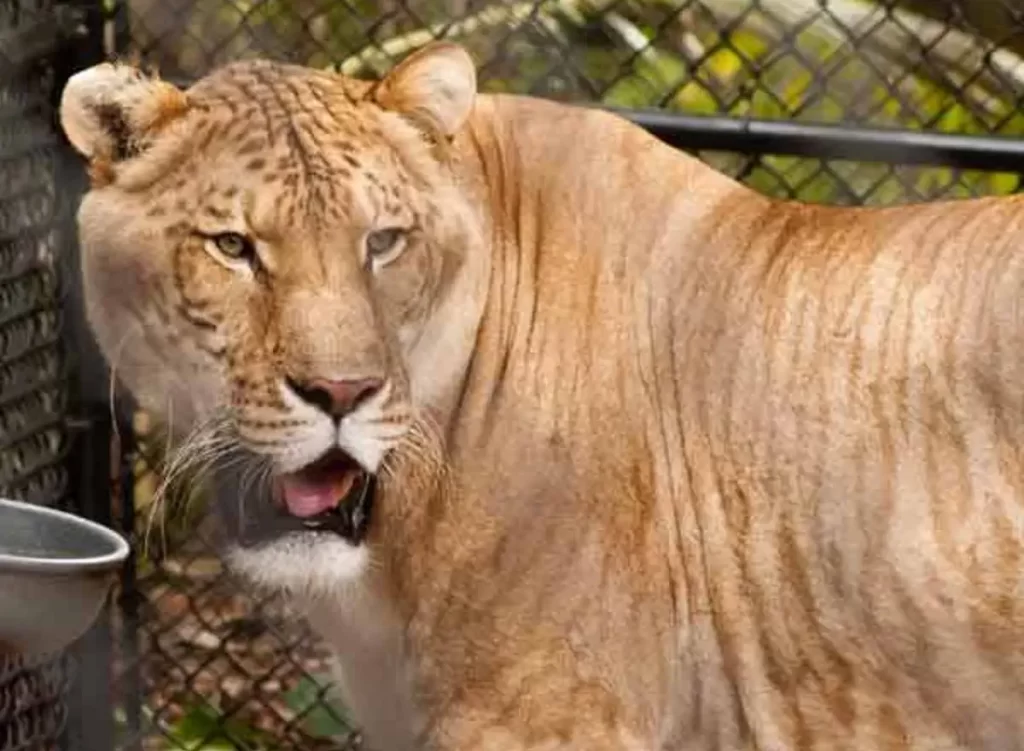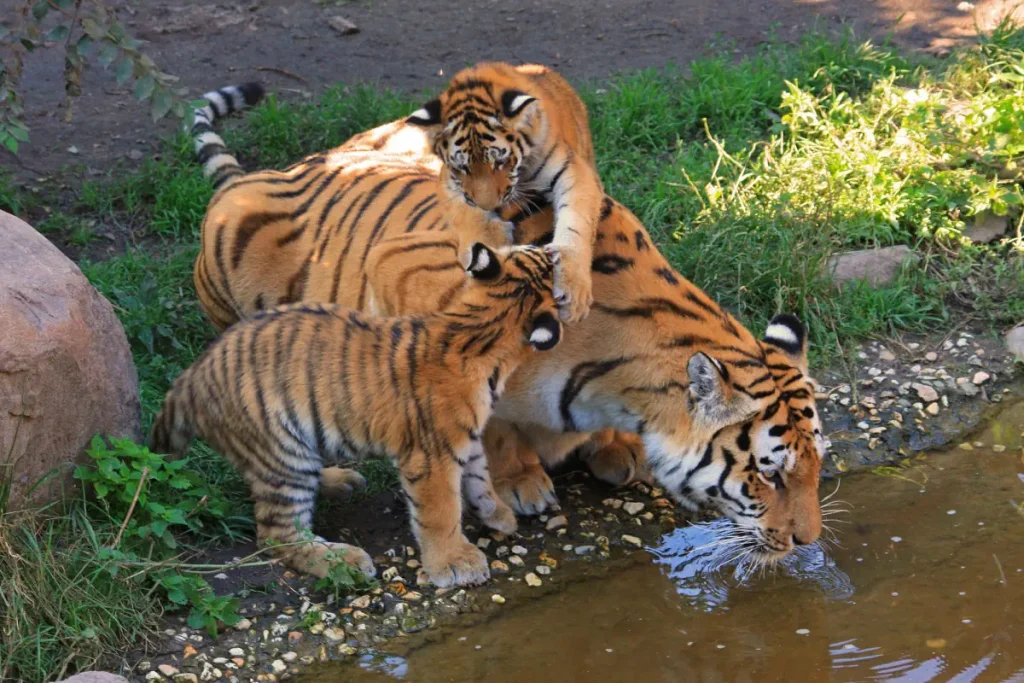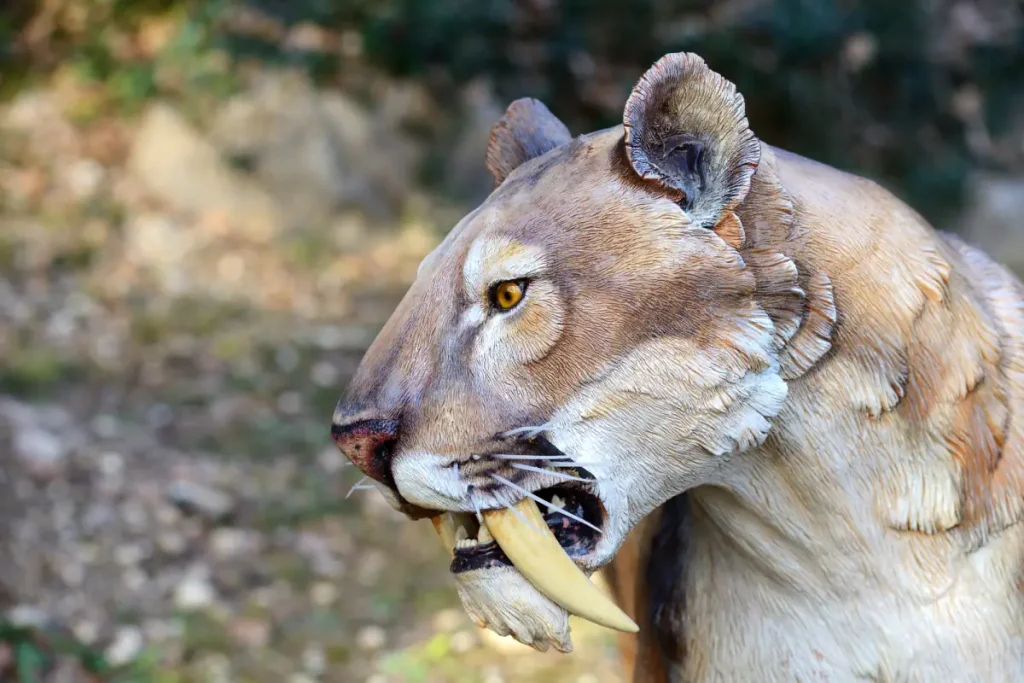The tiger (Panthera tigris) is probably one of the most exotic and beautiful animals in the world. It is one of the five species classified in the genus Panthera, the others being the lion, leopard, jaguar, and snow leopard (see notes 1). Here are 20 amazing tiger facts.
1. Tiger is the biggest living cat in the world
Tiger is the largest cat species (see note 2). In the tiger subspecies, the Siberian tiger (also called the Amur tiger) is considered the biggest. According to the Guinness Book of World Records, the male Siberian tiger (Panthera tigris
They average 3.15 meters (10 feet 4 inches) in length from the nose to the tip of the extended tail, stand 99-107 cm (39-42 inches) at the shoulder, and weigh about 265 kg (580 lb).
But the record-breaker is a Bengal tiger (P. t.
Tigers also have the strongest bite force in all Felidae, and the second strongest bite force of all carnivore land mammals, after the polar bear.

2. They are very good swimmers
Unlike many felids, tigers are strong swimmers. They often deliberately bathe in ponds, lakes, and rivers. They have been seen crossing rivers up to 7 km (4.3 mi) across and swimming up to 29 km (18 mi) in a day.
They are even able to carry prey through or capture it in the water. Among the big cats, only the jaguar, the only extant Panthera species native to the Americas and the third biggest cat in the world, shares a similar fondness for water.

3. Their hind legs are really strong
The hind legs of tigers are extremely powerful. A fully-grown tiger can leap over 8 meters (26 feet) and jump up to 5 meters (16 feet) vertically. See the famous video below in which a tiger attacks a man who riding an elephant in India.
Note that the tiger was directly attacking the man on the elephant but not the elephant itself. The tiger knew the man was a threat and clearly distinguishes him from the elephant – which is an indicator of the amazing intelligence of tigers.
4. The origin of “Tiger” name comes from the Mesopotamian river “Tigris”
The word panther derives from the classical Latin panthēra, itself from the ancient Greek pánthēr (πάνθηρ). The Greek pan- (πάν), meaning “all”, and thēr (θήρ), meaning “prey” bears the meaning of “predator of all animals”. In Mesopotamia, where the now-extinct Caspian tiger lived, there’s a river named “Tigris”, which is the eastern member of the two great rivers that define Mesopotamia, the other being the Euphrates.
Perhaps, the tiger’s name is coming from that river. The river flows south from the mountains of southeastern Turkey through Iraq and empties itself into the Persian Gulf. Some sources also point out that the original source of the word may have been the Persian

Related: 20 amazing lion facts
5. Tigers don’t live in Africa
Contrary to common belief, tigers don’t live in Africa. Today, they are found only in parts of South and Southeast Asia, and some pockets in Eastern Russia (Siberian taiga) and China. But, once, they roamed widely across eastern Eurasia, from the Black Sea in the west, to the Indian Ocean in the south, and from Kolyma to Sumatra in the east, and were even found in Turkey (Anatolia).
Unfortunately, over the past 100 years, they have lost 93% of their historic range. Today, the global population in the wild is estimated between 3,062 and 3,948 individuals. Around 100,000 tigers were living in the world at the start of the 20th century. But, in 2016, the WWF (see notes 3) declared that the world’s count of wild tigers has risen for the first time in a century.
6. They have the biggest canines of all cats

Tiger canines are the longest among living felids with a crown height of up to 90 mm (3.5 inches).
An adult tiger can go for up to two weeks without eating. Then consume anywhere from 15-40 kg (33-88 pounds) of meat in one sitting. In captivity, adult tigers are fed 3 to 6 kg (6.6 to 13.2 lb) of meat a day.
7. They can mate with lions
If a male tiger mates with a female lion, the offspring is named a tigon. If the father is a lion and the mother is a tiger, the offspring is named liger, the largest of all cats.

Related: 20 amazing liger facts
8. They are social animals
Tigers are territorial and generally solitary but at the same time social animals. They usually avoid each other, but, they are not always territorial and relationships between individuals can be complex. An adult of either sex will sometimes share its kill with others, even those who may not be related to them.
Once, the German-born American mammalogist, biologist, conservationist, and author George Schaller observed a male share a kill with two females and four cubs. What’s more, unlike male lions, male tigers allow females and cubs to feed on the kill before the male is finished with it.
9. They have a loud roar
A tiger’s roar can be heard up to 3 km (1.9 miles) away.
10. They sleep a lot
Like all cats, tigers sleep a lot – up to 18 hours a day.

11. Their tongues are barbed
Similar to the sandpaper tongue of a domestic house cat, the tongue of a tiger is equipped with sharp barbs. But, naturally, their tongue is much tougher. The barbs allow a tiger to groom and lick the fur off its prey.
12. The human-eater Champawat Tiger
There was a female Bengal tiger named Champawat Tiger, which was responsible for an estimated 436 deaths in Nepal and the Kumaon area of India, mostly during the 19th century. Her attacks have been listed in the Guinness Book of World Records as the highest number of fatalities from a tiger. She was shot dead in 1907.
13. Tigers are not exceptionally fast runners
A tiger can run as fast as 35 mph (56 km/h), but only for short distances. Most of their prey can outrun them, especially deer and antelope. That’s why tigers are ambush predators.
They are incredibly agile for short periods of time, though (when ambushing their prey, etc).
14. Their skin is also striped
They have striped fur but also striped skin, and no two tigers have the exact same pattern.
15. White tigers exist

In 1951, one single white tiger cub was found in the wild and taken by a hunter who killed his mother and normal-colored siblings. He was named Mohan and is the progenitor of most white tigers now in captivity. Today, white tigers live only in captivity as the white coat is only produced through severe inbreeding.
White tigers have brown stripes and crystal blue eyes, and some specimens in captivity have no stripes at all. According to Indian naturalist and conservationist Kailash Sankhala aka “tiger man” (30 January 1925 – 15 August 1994), the last white tiger ever seen in the wild was shot in 1958. Mohan died in 1970 aged 20.
The white tiger or bleached tiger is a pigmentation variant of the Bengal tiger. Such a tiger has the black stripes typical of the Bengal tiger but carries a white or near-white coat. The white fur is caused by a lack of the pigment pheomelanin, which is found in Bengal tigers with orange color fur.
When compared to Bengal tigers, the white Bengal tigers tend to grow faster and heavier than the orange Bengal tiger. They also tend to be somewhat bigger at birth, and as fully grown adults.
The existence of white Siberian tigers has not been scientifically documented, despite occasional unsubstantiated reports of sightings of white tigers in the regions where wild Siberian tigers live. It may be that the white mutation does not exist in the wild Siberian tiger population: no white Siberian tigers have been born in captivity.
Black tigers have been reported
Black tigers have been reported, but only a single pelt from illegal traders remains the only evidence. The pelt shows that the black only occurs on the top of the head and back but turns into stripes down the sides, unlike in other cats that are completely and truly black (or melanistic). Unconfirmed historical records also exist, from 1772 to as recent as 2014 (see notes 4).
16. Tiger cubs born blind
Like all cats, the newborn tiger cubs are born with their eyes closed and are, therefore, blind. Their eyes open between 6-12 days from birth. However, they do not have their full vision for a couple of weeks.
Newborn cubs weigh between 785 and 1,610 grams (1.75 to 3.5 lb).

For the first few months, the tigress is solely responsible for the protection and care of the cubs. She leaves her young for only short periods of time to drink and hunt.
A four-month-old tiger cub is about the same size medium-sized dog!
Cubs begin consuming solid food when they are 6-8 weeks old. When they are around two months old, they begin to follow their mothers out of the den.
They begin to hunt with their mother when they are 8-10 months old.
When they are 17-24 months old, they become independent.
17. The largest tiger ever lived was the now-extinct Ngandong tiger
The largest tiger subspecies ever lived on Earth was the now-extinct Ngandong tiger (Panthera tigris soloensis). They lived in what is now the Sundaland region of Indonesia during the Pleistocene epoch. Contrary to popular belief, modern tigers did not descend from prehistoric saber-tooth tigers. In fact, the two are not closely related.

The Ngandong tiger (Panthera tigris soloensis) is an extinct subspecies of tiger that lived in what is now the Sundaland region of Indonesia during the Pleistocene epoch. Fossils of P. t. soloensis have been found primarily in the village of Ngandong, hence the common name. Only seven fossils are known, making studying the animal difficult.
Heltler and Volmer (2007) estimated that a large male could potentially weigh up to 470 kilograms, making it one of the largest and most powerful felines of all time. Heltler and Volmer explained the unusually large size of the Ngandong tiger as the result of competition among the large felids, canids, and hyenas that inhabited Java at the time.
Although Raúl Valvert (2014) later estimated the straight length to be between 172 to 233 centimeters, while the length over the curves was estimated to be 258-350 cm. The minimum weight for females was estimated at 143 kg, although males can weigh up to 368 kg, with an exceptional specimen weighing up to 400 kg.

Related: Top 5 largest prehistoric cats
18. They cannot taste sweet
Like all felines, tigers cannot taste sweet, and also they are hypercarnivores, which means they live exclusively on meat.
19. House cats and tigers share 95.6 percent of their DNA
Your house cat is actually a small tiger! According to a 2013 study (see notes 5), domestic house cat shares about 95.6% of their DNA with tigers, from which they diverged on the evolutionary tree about 10.8 million years ago.

20. Tigers cannot purr
Unlike your domestic cat, tigers cannot purr. The largest cats that can purr are cougars (also called pumas, mountain lions, catamounts, Florida panthers, painters, ghost cats, etc). That’s why cougars are considered part of the lesser/small cat classification when it comes to their ability to purr and not roar.
Some Not-So-Amazing Tiger Facts
The remaining six tiger subspecies (Bengal, Indochinese, Malayan, Siberian aka the Amur, Sumatran, and South China) have been classified as endangered by the International Union for Conservation of Nature (IUCN). As always, humans are the cause: nearly 50% of tiger cubs die before they reach one year old, often because their mothers have been shot.
Today, there are as many tigers living either in zoos or wildlife parks as there are in the wild. Tigers have been (and are still) widely hunted throughout their range for sport, for the fur trade, and for the traditional Asian medicine market.

South China tiger is the most critically endangered subspecies of tiger and one of the 10 most endangered animals in the world. In 1960, over 4,000 South China tigers were living in China. Today, there are fewer than 20 left in the wild and just 60 in zoos. They were hunted to near extinction because the Chinese government declared they were “pests”.
Siberian tigers are also critically endangered. Despite conservation efforts, it could become extinct in the wild in the next ten years.
The Bali tiger, Caspian tiger, and Javan tiger became extinct in the 20th century. They were hunted to extinction.
Habitat loss is also a big three to tigers.
Notes
- Results of genetic analysis indicate that the beautiful snow leopard also belongs to the Panthera, a classification that was accepted by IUCN (International Union for Conservation of Nature) assessors in 2008.
- Tiger is the largest cat species, but the largest living cat is not a tiger, it is a liger named Hercules.
- The World Wide Fund for Nature (WWF), formerly named the World Wildlife Fund, is an international non-governmental organization founded in 1961, working in the field of wilderness preservation, and the reduction of human impact on the environment.
- According to some Indian news websites, on July 28, 2014, at Nandankanan zoo, four cubs were born to a white tigress and one of them was black. But, despite it being in 2014, they deliver no photo of the cub. So, it’s good to take their claim with a pinch of salt. The photos you get when you google “black tiger cub” do not belong to a black tiger cub at all. All the photos belong to the same cute black Amur leopard cub.
- The research, published in Nature Communications, and originally titled “The tiger genome and comparative analysis with lion and snow leopard genomes” was led by scientists in South Korea, in collaboration with colleagues in China, the US, Russia, Namibia, South Africa, The Netherlands, Denmark, Saudi Arabia, India and Mongolia.
Sources
- Tiger on Wikipedia
- Tiger Facts on Big Cat Rescue web site
- Panthera on Wikipedia
- Bite forces and evolutionary adaptations to feeding ecology in carnivores (Ecology)
- Largest feline carnivore on Guinness Book of World Records
- Tigris on Wikipedia
- World Wide Fund for Nature on Wikipedia
- George Schaller on Wikipedia
- 64 Magnificent Facts about Tigers on Fact Retriever
- Do big cats roar or purr, or both? on wildsanctuary.org
- How Many Elephants are Left in the World in 2025? - August 17, 2025
- Moon Landings: All-Time List [1966-2025] - February 2, 2025
- What Is Max-Q and Why Is It Important During Rocket Launches? - January 16, 2025
